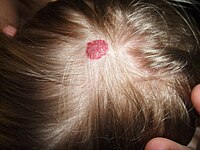
Photo from wikipedia
Infantile haemangiomas are common benign tumours of infancy, which can be treated effectively with beta-blockers such as propranolol and atenolol. Different types of beta-blockers may result in different long-term aesthetic… Click to show full abstract
Infantile haemangiomas are common benign tumours of infancy, which can be treated effectively with beta-blockers such as propranolol and atenolol. Different types of beta-blockers may result in different long-term aesthetic outcomes. This study evaluated the difference in long-term aesthetic outcomes between infantile haemangiomas treated with either propranolol or atenolol, including the perspective of physicians, parents, and children. Children, aged ≥6 years, treated with propranolol or atenolol for infantile haemangioma during infancy, participated in this 2-centre cross-sectional study. The primary endpoint was change in appearance of the infantile haemangioma from pre-treatment to follow-up, using a physician-rated visual analogue scale (VAS). Secondary outcomes were the Patient Observer Scar Assessment Scale (physician- and parent-rated) and a VAS (child-rated), assessing the residual lesion. In total, 103 children (35 treated with propranolol, 68 with atenolol) were analysed. No differences were found between children treated with propranolol and children treated with atenolol on physician-rated VAS (p = 0.10) or any secondary outcomes. Physicians indicated a large aesthetic improvement from pre-treatment to follow-up. Physicians, parents and children were positive about the current state of the residual lesion. Minor sequelae were common (86%). These results, in combination with the favourable safety profile of atenolol, should be considered when choosing beta-blocker treatment for infantile haemangioma.
Journal Title: Acta Dermato-Venereologica
Year Published: 2022
Link to full text (if available)
Share on Social Media: Sign Up to like & get
recommendations!